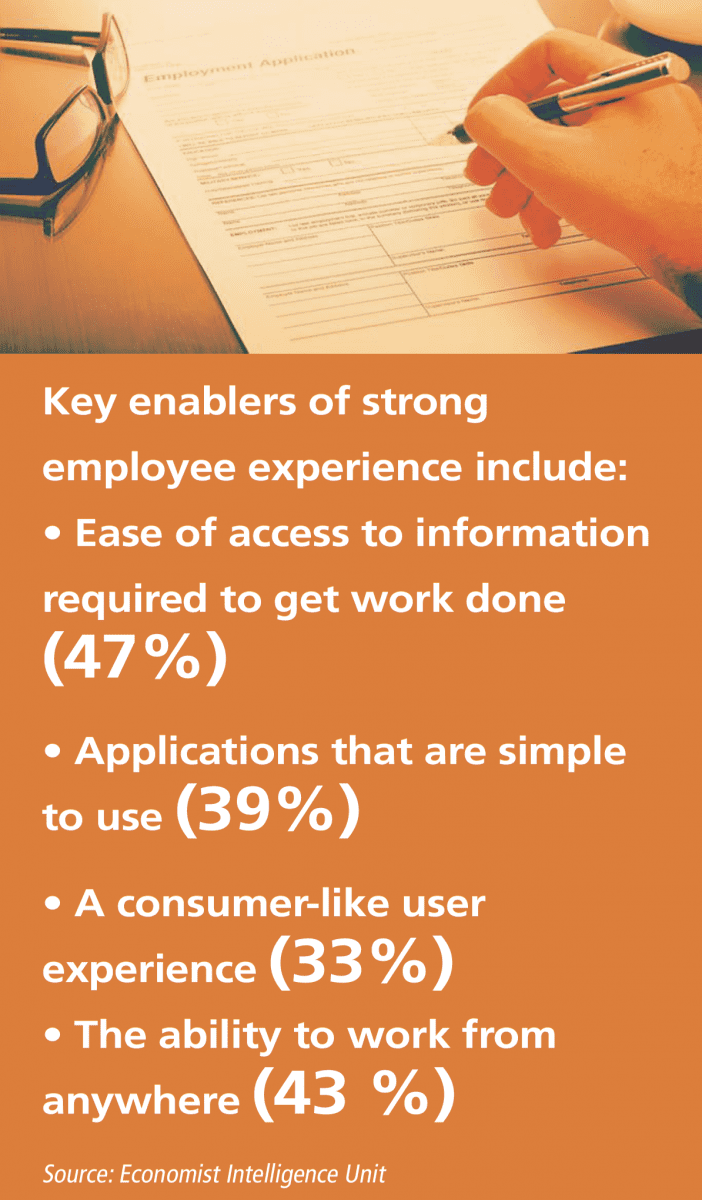HR and IT need to partner to fix the broken employee experience.
By Donna Kimmel
When it comes to attracting and retaining talent, employee experience is one of the most critical elements of success. Around the world, the gap between the number of jobs available and the people available to fill them is the largest it has ever been. And competition is stiff. To get the talent they want and need to power and move their businesses forward, companies need to create an environment that inspires people to do great work.
Innovative companies understand this. A new research study, The Experience of Work, conducted by the Economist Intelligence Unit (EIU), found that of the 1,100 surveyed senior executives across eight countries and industry sectors, 30 percent cited talent retention as the top reason for improving employee experience, just behind productivity and employee engagement (40 percent). And this isn’t just a function of human resources.
Total rewards certainly play an important role in the employee experience. But technology is fast becoming a key driver that can make or break it. According to the EIU study, companies that use technology to provide employees with tools that make work more efficient and meaningful can deliver a superior employee experience that enables them to attract the people they need, keep them engaged and productive, and improve their business results.
Align the Troops
According to Gartner, by 2021, 75 percent of organizations will include employee experience improvement as a performance objective for HR and IT groups. And this will require the functions to partner in totally new ways.
It used to be that competitive salaries, benefits, and career development initiatives were enough to find and keep talent. And make no mistake, these things -along with learning and development opportunities; initiatives that foster diversity, inclusion, and belonging; and opportunities to engage with community causes -are still vital.
 But to compete and win in the raging battle for talent, companies need to up their game and remove frustration from work. And this is where IT comes into play.
But to compete and win in the raging battle for talent, companies need to up their game and remove frustration from work. And this is where IT comes into play.
For the last decade, IT has steadily put in place technologies it thought would streamline entire functions and fuel collaboration. But the new tech has actually had the opposite effect.
Employees today deal with as many as 11 different apps on a daily basis to get their work done. And in most cases, they only make work more complicated. The average employee spends almost 10 hours a week just searching for the information they need to do their jobs. And managers waste 25 percent of their time on routine, administrative tasks. They are frustrated and disengaged as a result. In fact, according to Gallup, 87 percent of employees around the world are disengaged or actively disengaged at work. It’s a major -and expensive -problem that Gallup estimates costs global businesses $7 trillion in lost productivity, turnover, and worker frustration.
Share Responsibility
Nearly identical numbers of surveyed IT and HR executives (74 percent and 75 percent, respectively) feel personally responsible for improving the employee experience. How can the two functions partner to achieve their mutual goal?
1. Focus on employee needs. Fostering a premiere employee experience follows a similar process to product development and customer service. The first step? Market research. Uncover employees’ pain points and map out actions to address them.
Among the key enablers of strong employee experience identified in The Experience of Work were ease of access to information required to get work done (47 percent), applications that are simple to use (39 percent), a consumer-like user experience (33 percent), and the ability to work from anywhere (43 percent).
2. Keep things simple and flexible. Employees today expect things at work to be as easy as they are in their personal lives -particularly millennials and Generation Z who now account for the bulk of the global workforce. They also want the freedom to work when, where, and how they want. In fact, according to a recent study from Citrix and OnePoll, 70 percent of knowledge workers living in urban locales say they would move to outlying areas and work remotely if they could do their jobs at the same level. And according to Upwork, gig workers are expected to account for more than half of the total workforce by 2027.
To attract and retain talent in today’s tight labor market, companies need to rethink what “workplace” means, create digital environments that accommodate these new work models, and deliver the tools and information employees need to do their best work in a simple, unified way.
3. Remove the friction. A positive employee experience requires removing friction from work and facilitating better collaboration. Digitization has driven innovation and progress, but it has also created a complex technology ecosystem that can slow the pace of work.
Less than half (46 percent) of surveyed executives in The Experience of Work feel the applications and devices provided by their organizations make a positive contribution to their employees’ experiences.
And this needs to change. HR and IT must work together to identify technology that is actually helpful to employees and deliver solutions that free them to collaborate and innovate.
4. See the future. The future of work is dynamic and decentralized, and employees are demanding a similar experience. Businesses that pair HR and IT to put the right insights and information at employees’ fingertips and empower them to be and do their best can redefine what work means and engage their employees in new ways that enhance their success.
Donna Kimmel is EVP and chief people officer at Citrix.














